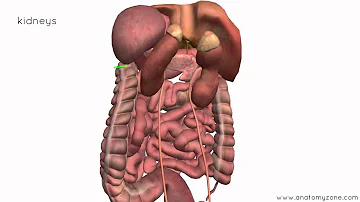What are retroperitoneal vs intraperitoneal organs?
Intraperitoneal: peritonealized organs having a mesentery, such as the stomach, small intestine (jejunum and ileum), transverse colon, liver and gallbladder. Retroperitoneal: organs without a mesentery and associated with posterior body wall, such as the aorta, inferior vena cava, kidneys and suprarenal glands.
What organs are retroperitoneal and peritoneal?
The area in the back of the abdomen behind the peritoneum (the tissue that lines the abdominal wall and covers most of the organs in the abdomen). The organs in the retroperitoneum include the adrenal glands, aorta, kidneys, esophagus, ureters, pancreas, rectum, and parts of the stomach and colon.

What are intraperitoneal organs?
Your visceral peritoneum wraps around your abdominal organs, particularly your stomach, liver, spleen and parts of your small and large intestines. Organs inside of your visceral peritoneum are called “intraperitoneal.” The others are “retroperitoneal.”
How do you remember intraperitoneal and retroperitoneal organs?
One easy way to remember which abdominopelvic organs are retroperitoneal is to use a mnemonic such as SAD PUCKER:
- S = Suprarenal (adrenal) glands.
- A = Aorta/Inferior Vena Cava.
- D = Duodenum (second and third segments)
- P = Pancreas.
- U = Ureters.
- C = Colon (ascending and descending only)
- K = Kidneys.
- E = Esophagus.
What makes an organ intraperitoneal?
Within the peritoneal cavity (the area that contains the abdominal organs).
What is the difference between retroperitoneal and peritoneal?
The peritoneum is a double-layer sheet that protects the organs in the abdominal cavity, while the retroperitoneal space is located behind the peritoneum and separated from the former by the parietal peritoneum.
Is the pancreas peritoneal or retroperitoneal?
The pancreas is a retroperitoneal organ with a close anatomic relationship to the peritoneal reflections in the abdomen, including the transverse mesocolon and the small bowel mesentery, and is directly contiguous to peritoneal ligaments such as the hepatoduodenal ligament, gastrohepatic ligament, splenorenal ligament, …
Is Kidney an intraperitoneal organ?
The kidneys are bean-shaped organs located in the upper retroperitoneal region of the abdomen. That is, they are located behind the smooth peritoneal lining of the upper part of the abdominal cavity, between it and the posterior body wall. Therefore, they are actually outside the peritoneal cavity.
Why is kidney called retroperitoneal?
The kidneys are considered “retroperitoneal” organs, which means they sit behind a lining in the abdominal cavity, unlike all other abdominal organs.
Is bladder retroperitoneal?
The ureters and urinary bladder are retroperitoneal organs, which means that they lie behind the peritoneum (the peritoneum is discussed in depth, elsewhere). The tunics (aka, layers) of their walls are specialized to accommodate changes in urine volume and to actively move urine through the urinary tract.
Is the pancreas intraperitoneal or retroperitoneal?
retroperitoneal organ
The pancreas is a retroperitoneal organ with a close anatomic relationship to the peritoneal reflections in the abdomen, including the transverse mesocolon and the small bowel mesentery, and is directly contiguous to peritoneal ligaments such as the hepatoduodenal ligament, gastrohepatic ligament, splenorenal ligament, …
Why are kidneys called retroperitoneal?
The kidneys are considered “retroperitoneal” organs, which means they sit behind a lining in the abdominal cavity, unlike all other abdominal organs.
What is the difference between peritoneal and retroperitoneal?
The peritoneum is a double-layer sheet that protects the organs in the abdominal cavity, while the retroperitoneal space is located behind the peritoneum and separated from the former by the parietal peritoneum.
Is gallbladder peritoneal or retroperitoneal?
The liver, gallbladder, and spleen are contained in the peritoneal cavity. The retroperitoneal space—the area posterior to the peritoneal cavity—houses the pancreas, kidneys, and suprarenal glands (Fig. 34.1).
Is uterus intraperitoneal or retroperitoneal?
The body of the uterus is surrounded by peritoneum, hence it lies intraperitoneal. The first part of the rectum lies posterior to the peritoneum, hence it is retroperitoneal.
What are the three retroperitoneal organs?
The retroperitoneal space contains the kidneys, adrenal glands, pancreas, nerve roots, lymph nodes, abdominal aorta, and inferior vena cava.
Are urinary organs retroperitoneal?
The ureters and urinary bladder are retroperitoneal organs, which means that they lie behind the peritoneum (the peritoneum is discussed in depth, elsewhere). The tunics (aka, layers) of their walls are specialized to accommodate changes in urine volume and to actively move urine through the urinary tract.
Are ovaries intra or retroperitoneal?
- Although the ovary is considered an intraperitonal organ, it only has a peritoneal duplicate but its surface isn't covered by peritoneum.
Is bladder retroperitoneal or intraperitoneal?
The ureters and urinary bladder are retroperitoneal organs, which means that they lie behind the peritoneum (the peritoneum is discussed in depth, elsewhere).
Is the pancreas Intraperitoneal or retroperitoneal?
- The pancreas is a retroperitoneal organ with a close anatomic relationship to the peritoneal reflections in the abdomen, including the transverse mesocolon and the small bowel mesentery, and is directly contiguous to peritoneal ligaments such as the hepatoduodenal ligament, gastrohepatic ligament, splenorenal ligament, …
Is the bladder intraperitoneal or retroperitoneal?
The ureters and urinary bladder are retroperitoneal organs, which means that they lie behind the peritoneum (the peritoneum is discussed in depth, elsewhere).
Are kidneys intraperitoneal organs?
The kidneys are considered “retroperitoneal” organs, which means they sit behind a lining in the abdominal cavity, unlike all other abdominal organs.
Is urinary bladder retroperitoneal?
The ureters and urinary bladder are retroperitoneal organs, which means that they lie behind the peritoneum (the peritoneum is discussed in depth, elsewhere). The tunics (aka, layers) of their walls are specialized to accommodate changes in urine volume and to actively move urine through the urinary tract.

